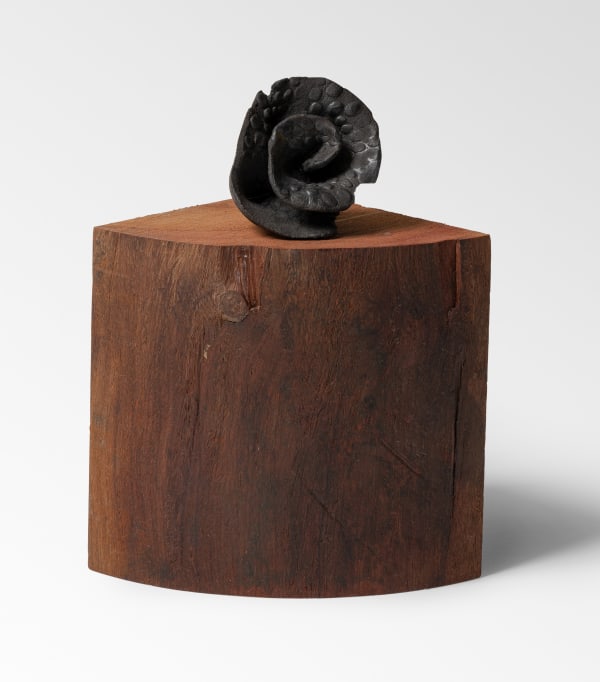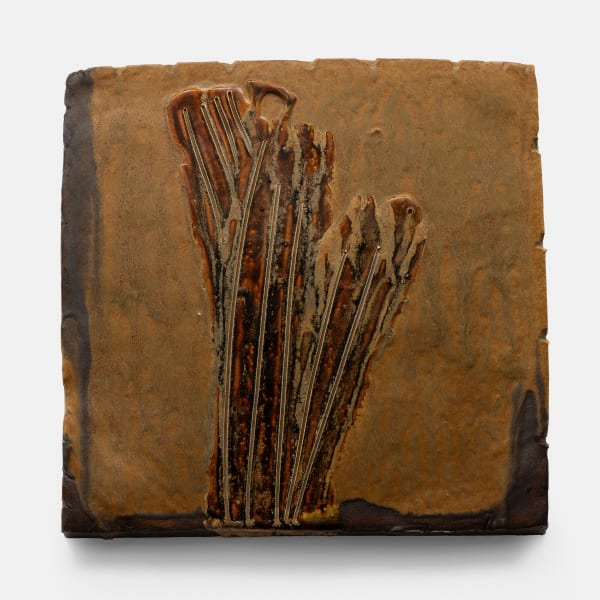At the end of the small hours Phoebe Collings-James
Phoebe Collings-James presents At the end of the small hours, the artist’s first solo show in Brussels.
The exhibition showcases diverse ceramic sculptures from distinct series yet connected through an evolving narrative of dreams. The reflection of a constellation of ideas, the works both incite and provoke the viewer to conceptualize, or dream, of possible territories such as those evoked in the poetry of Aimé Césaire, the visual art of Beverly Buchanan, or the music of Barrington Levy, among many guiding influences within the artist’s realm of research and reference.
Using dreams as decolonizing tools, Collings-James explores ceramics’ relevance in contemporary society through installations that foster connections within and beyond the conceptual space. In an interplay of color dominated by deep blacks and rich blues, the works evoke the artist’s vision of moonlight shimmering on open water, capturing the elusive quality of twilight and the space between reality and reverie.
The Infidel series, a central body of work revisited in the Brussels show, is defined as a heretic anthology made of a group of creature-esque forms arranged together in procession. The sculptures, at once shocking and fragile, portray uncategorizable armless shapes with protruded beaks, barely balancing themselves on rolling curves or points. Borrowing from West African and Caribbean ceramic techniques of creating rolling vessels, Collings-James imagines Infidel as a container of national, political, or spiritual teachings. The decisive title of this series stems from the historical archetype of a revolutionary or disbeliever, reclaimed in celebration of the outsider. The issue of agency resurfaces through their display, lingering together or moving slowly with no apparent purpose – loitering as a form of resistance. Thus, At the end of the small hours is an engagement that calls for an awareness unbound by a fixed dimension, unfolding instead in relation to the world around us. It beckons us to dwell and to belong as active participants in the universal “nothingness and thingness.”1
Narratives of inclusion and exclusion form the backdrop of another body of work introduced in the exhibition. a mouthpiece for Terry (2025) presents Collings-James’s continuous inquiry into sound and musical expression, often incorporated as elements in the artist’s installations. In this (allegedly) silent series, named in reference to the late North American artist and musician Terry Adkins, brass mouthpieces sourced from musical instruments stick out from a group of unfired red clay sculptures. This musical ensemble serves as a tool to vocalize a lineage of different knowledges and symphonize remembrance of Black and feminist political histories.
Telling stories through the medium of ceramics serves to both remember and forecast other beliefs beyond those within structured systems. A series of clay paintings on the gallery’s walls is presented as an allegory of a dream sequence. Imagined as archaeological clay tablets used as a script by Babylonian civilization, each work takes its image from fragments of dream memories gathered during sleep and waking life and recalling scenes and politics through an indecipherable symbology. The contradicting metaphor of Babylon, evoked as a utopian metropolis throughout history, but which burned down through progressive cultural emancipation, allows Collings-James to draw ties with the Black diaspora and queer experiences, blending knowledges beyond hierarchies of representation. Finally, black black rose (2025) asserts a recurring motif of remembrance deposited as an offering throughout the exhibition, a signpost on how to move forward as both an artist and a witness.
[1] “(…) art requires and allows us to linger, in the exhausted, exhaustive space between something and nothing, nothing and everything, so that we can begin to understand again, how the interrelation of wealth and poverty is all bound up with the question, which is to say the study, in things, of nothingness and thingness”. Fred Moten, Black and Blur (Durham, NC: Duke University Press, 2017)
-
 Phoebe Collings-James, black black rose, 2025
Phoebe Collings-James, black black rose, 2025 -
![Phoebe Collings-James, Infidel [Innervisions], 2025](data:image/gif;base64,R0lGODlhAQABAIAAAAAAAP///yH5BAEAAAAALAAAAAABAAEAAAIBRAA7) Phoebe Collings-James, Infidel [Innervisions], 2025
Phoebe Collings-James, Infidel [Innervisions], 2025 -
![Phoebe Collings-James, Infidel [land back], 2025](data:image/gif;base64,R0lGODlhAQABAIAAAAAAAP///yH5BAEAAAAALAAAAAABAAEAAAIBRAA7) Phoebe Collings-James, Infidel [land back], 2025
Phoebe Collings-James, Infidel [land back], 2025 -
![Phoebe Collings-James, Infidel [fast love], 2025](data:image/gif;base64,R0lGODlhAQABAIAAAAAAAP///yH5BAEAAAAALAAAAAABAAEAAAIBRAA7) Phoebe Collings-James, Infidel [fast love], 2025
Phoebe Collings-James, Infidel [fast love], 2025 -
![Phoebe Collings-James, Infidel [night shade], 2025](data:image/gif;base64,R0lGODlhAQABAIAAAAAAAP///yH5BAEAAAAALAAAAAABAAEAAAIBRAA7) Phoebe Collings-James, Infidel [night shade], 2025
Phoebe Collings-James, Infidel [night shade], 2025 -
 Phoebe Collings-James, Freeee ASSOCIATE, 2025
Phoebe Collings-James, Freeee ASSOCIATE, 2025 -
![Phoebe Collings-James, Infidel [blue blurrr], 2025](data:image/gif;base64,R0lGODlhAQABAIAAAAAAAP///yH5BAEAAAAALAAAAAABAAEAAAIBRAA7) Phoebe Collings-James, Infidel [blue blurrr], 2025
Phoebe Collings-James, Infidel [blue blurrr], 2025 -
![Phoebe Collings-James, Infidel [a house for beverly], 2025](data:image/gif;base64,R0lGODlhAQABAIAAAAAAAP///yH5BAEAAAAALAAAAAABAAEAAAIBRAA7) Phoebe Collings-James, Infidel [a house for beverly], 2025
Phoebe Collings-James, Infidel [a house for beverly], 2025 -
 Phoebe Collings-James, ever new, 2025
Phoebe Collings-James, ever new, 2025 -
![Phoebe Collings-James, Infidel [yarrow], 2025](data:image/gif;base64,R0lGODlhAQABAIAAAAAAAP///yH5BAEAAAAALAAAAAABAAEAAAIBRAA7) Phoebe Collings-James, Infidel [yarrow], 2025
Phoebe Collings-James, Infidel [yarrow], 2025 -
![Phoebe Collings-James, Infidel [devils chariot], 2025](data:image/gif;base64,R0lGODlhAQABAIAAAAAAAP///yH5BAEAAAAALAAAAAABAAEAAAIBRAA7) Phoebe Collings-James, Infidel [devils chariot], 2025
Phoebe Collings-James, Infidel [devils chariot], 2025 -
 Phoebe Collings-James, B̶l̶i̶s̶s̶ 37, 2025
Phoebe Collings-James, B̶l̶i̶s̶s̶ 37, 2025 -
 Phoebe Collings-James, at the end at the end at, 2025
Phoebe Collings-James, at the end at the end at, 2025 -
 Phoebe Collings-James, it's not too late, 2025
Phoebe Collings-James, it's not too late, 2025 -
 Phoebe Collings-James, blood lines, 2025
Phoebe Collings-James, blood lines, 2025 -
![Phoebe Collings-James, Infidel [free association], 2025](data:image/gif;base64,R0lGODlhAQABAIAAAAAAAP///yH5BAEAAAAALAAAAAABAAEAAAIBRAA7) Phoebe Collings-James, Infidel [free association], 2025
Phoebe Collings-James, Infidel [free association], 2025 -
![Phoebe Collings-James, Infidel [stripe], 2025](data:image/gif;base64,R0lGODlhAQABAIAAAAAAAP///yH5BAEAAAAALAAAAAABAAEAAAIBRAA7) Phoebe Collings-James, Infidel [stripe], 2025
Phoebe Collings-James, Infidel [stripe], 2025 -
![Phoebe Collings-James, Infidel [celadon fix], 2025](data:image/gif;base64,R0lGODlhAQABAIAAAAAAAP///yH5BAEAAAAALAAAAAABAAEAAAIBRAA7) Phoebe Collings-James, Infidel [celadon fix], 2025
Phoebe Collings-James, Infidel [celadon fix], 2025 -
 Phoebe Collings-James, a rose, a bridge, a house, 2025
Phoebe Collings-James, a rose, a bridge, a house, 2025 -
 Phoebe Collings-James, The masquerade is over, 2025
Phoebe Collings-James, The masquerade is over, 2025


![Phoebe Collings-James, Infidel [Innervisions], 2025](https://artlogic-res.cloudinary.com/w_600,c_limit,f_auto,fl_lossy,q_auto,dpr_auto/artlogicstorage/mendeswooddm/images/view/95d4a9d1840b80d3880a00714a17d100j/mendeswooddm-phoebe-collings-james-infidel-innervisions-2025.jpg)
![Phoebe Collings-James, Infidel [land back], 2025](https://artlogic-res.cloudinary.com/w_600,c_limit,f_auto,fl_lossy,q_auto,dpr_auto/artlogicstorage/mendeswooddm/images/view/d0b7dde9b1600cf755a5b3e15d42709ej/mendeswooddm-phoebe-collings-james-infidel-land-back-2025.jpg)
![Phoebe Collings-James, Infidel [fast love], 2025](https://artlogic-res.cloudinary.com/w_600,c_limit,f_auto,fl_lossy,q_auto,dpr_auto/artlogicstorage/mendeswooddm/images/view/c0118b7c806faa70f2b2514e879fa51aj/mendeswooddm-phoebe-collings-james-infidel-fast-love-2025.jpg)
![Phoebe Collings-James, Infidel [night shade], 2025](https://artlogic-res.cloudinary.com/w_600,c_limit,f_auto,fl_lossy,q_auto,dpr_auto/artlogicstorage/mendeswooddm/images/view/45d03d4d4ec5c16ece39327a6483ca01j/mendeswooddm-phoebe-collings-james-infidel-night-shade-2025.jpg)

![Phoebe Collings-James, Infidel [blue blurrr], 2025](https://artlogic-res.cloudinary.com/w_600,c_limit,f_auto,fl_lossy,q_auto,dpr_auto/artlogicstorage/mendeswooddm/images/view/3594fdf7cae1ea62c46a4eb4effd56c4j/mendeswooddm-phoebe-collings-james-infidel-blue-blurrr-2025.jpg)
![Phoebe Collings-James, Infidel [a house for beverly], 2025](https://artlogic-res.cloudinary.com/w_600,c_limit,f_auto,fl_lossy,q_auto,dpr_auto/artlogicstorage/mendeswooddm/images/view/c3dad0b845a48d83a5d7ad44240d1c1dj/mendeswooddm-phoebe-collings-james-infidel-a-house-for-beverly-2025.jpg)

![Phoebe Collings-James, Infidel [yarrow], 2025](https://artlogic-res.cloudinary.com/w_600,c_limit,f_auto,fl_lossy,q_auto,dpr_auto/artlogicstorage/mendeswooddm/images/view/e3319ad24bfab1777256166d19a0a87fj/mendeswooddm-phoebe-collings-james-infidel-yarrow-2025.jpg)
![Phoebe Collings-James, Infidel [devils chariot], 2025](https://artlogic-res.cloudinary.com/w_600,c_limit,f_auto,fl_lossy,q_auto,dpr_auto/artlogicstorage/mendeswooddm/images/view/5d8b1fd04947753cf70c003bbfae4bb2j/mendeswooddm-phoebe-collings-james-infidel-devils-chariot-2025.jpg)




![Phoebe Collings-James, Infidel [free association], 2025](https://artlogic-res.cloudinary.com/w_600,c_limit,f_auto,fl_lossy,q_auto,dpr_auto/artlogicstorage/mendeswooddm/images/view/955faa586ccc0a6dbbfd463331676adej/mendeswooddm-phoebe-collings-james-infidel-free-association-2025.jpg)
![Phoebe Collings-James, Infidel [stripe], 2025](https://artlogic-res.cloudinary.com/w_600,c_limit,f_auto,fl_lossy,q_auto,dpr_auto/artlogicstorage/mendeswooddm/images/view/d7b6606e17dd18537595640a06998a25j/mendeswooddm-phoebe-collings-james-infidel-stripe-2025.jpg)
![Phoebe Collings-James, Infidel [celadon fix], 2025](https://artlogic-res.cloudinary.com/w_600,c_limit,f_auto,fl_lossy,q_auto,dpr_auto/artlogicstorage/mendeswooddm/images/view/833894785ed687a71deb291b022c1153j/mendeswooddm-phoebe-collings-james-infidel-celadon-fix-2025.jpg)


